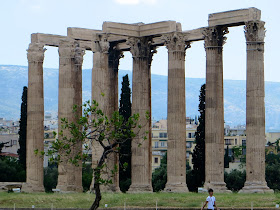We joined a free walking tour this morning, which took us all over the city and allowed us to see every major site and was really interesting. When the tour was over, we picnicked in the National Gardens, and then did a little shopping in the market area, before heading home to rest for a while. We also did a sunset hike this evening up Lycabettus Hill, where we experienced breathtaking views of the entire city.
 |
Poseidon's Spring
According to the stories, Poseidon and Athena had a contest
to see who would become the protector of the city.
Poseidon struck the ground with his trident and created this spring.
Athena used her staff to create an olive tree, which could be used for food and
warmth and building. The people liked her offer better and named the city after her. |
 |
Hadrian's Library
Hadrian was a Roman emperor who built a huge library in Athens
during his reign, because he wanted Athens to be the cultural center of the empire.
Unfortunately, all the books were in Latin, which the common Greek people couldn't read at all. |
 |
The Acropolis
It means "top city," and it is where The Parthenon (Athena's Temple)
is located. There are also several other lesser temples on top up there,
which is what you can see on the right hand side of the picture. |
 |
The Roman Agora
This was the marketplace of Athens during the time of the Roman Empire. |
 |
Temple of Hephaestus
This temple has been the best preserved and sits next to the Ancient Agora. |
 |
Lycabettus Hill
According to the myths, Athena picked up a huge rock to bring to The Acropolis
to place at her temple, but while she was on her way, she was interrupted by messengers
with bad news, and she dropped the boulder to form this hill, which then became
a higher point than The Acropolis, where her temple was located. |
 |
Hadrian's Arch
This arch divided the "old city," where The Acropolis is
(and which you can just see peeking through the arch),
from the "new city," where the Temple of Zeus could be found. |
 |
Temple of Zeus
In its prime, this temple would have been much larger than
The Parthenon. When the columns were being erected, liquid lead was poured inside
to harden and add stability to the structures. If you look closely, you can see large holes
drilled near the bottom of the columns. When the Ottoman Turks occupied the land,
they figured out there was lead in the columns and harvested some of it to make bullets. |
 |
The Olympic Stadium
Weston, our lover of all sports, was so excited to see the Olympic Stadium,
which was built for the first modern olympics in 1896. |
 |
The Parliament Building
This was formerly the royal palace and is now the seat of government. |
 |
The changing of the guard at the parliament building
These are Evzone Soldiers, dressed in the traditional uniform,
which is now purely ceremonial. Supposedly, the black pom-poms
on the shoes hide a blade, which was once used in close range fighting. |
 |
National Garden
We had a lovely picnic and some gigantic fun playing on the humongous trees. |
 |
Fruit Street Vendor
The kids were so excited to each get to pick out a kilo of fruit
from one of the beautifully arrayed carts on the street. |
 |
Sunset hike up Lycabettus Hill
Our tour guide mentioned this was the best place in town to see the sunset,
so we couldn't resist adding this evening hike to our agenda. |
 |
The Parthenon
The Parthenon sits on the left hand side of the picture,
while some of the lesser temples are on the right.
You can see the Saronic Gulf in the background. |
 |
The Glowing Acropolis
All of the temples are lit up when the sun goes down,
and it is absolutely stunning! |
















No comments:
Post a Comment
Say what you need to say